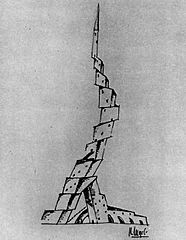Avant-garde architecture

아방가르드 건축은 혁신적이고 급진적인 건축을 말한다. 다양한 건축가와 운동이 이러한 방식으로 특징지어졌고, 특히 모더니즘이 그랬다. 다른 예로는 구성주의, 신조형주의(데 스테일), 신-미래주의, 해체주의, 매개변수주의 및 표현주의가 있다.
Avant-garde architecture is architecture which is innovative and radical. There have been a variety of architects and movements whose work has been characterised in this way, especially Modernism. Other examples include Constructivism, Neoplasticism (De Stijl), Neo-futurism, Deconstructivism, Parametricism and Expressionism.
개념
Concept
아방가르드 건축은 미학 측면에서 진보적인 것으로 묘사되어 왔다. 그렇지만, 그것은 광범위한 미학적 및 정치적 스펙트럼을 다루는 것으로 유명하다. 그것은 진보 좌파와 관련이 있지만 정치와 미학에서는 비정치적, 우익적, 보수적이라는 평가를 받기도 한다. 그것은 또한 반-엘리트주의적이고 대중문화의 오염에 열려 있는 모더니즘 내의 한 흐름으로 간주되기도 한다.
Avant-garde architecture has been described as progressive in terms of aesthetics. However, it is noted for covering a broad range of aesthetic and political spectrum. It is associated with the liberal left but also cited as apolitical, right-wing, and conservative in its politics and aesthetics. It is also considered a stream within modernism that is anti-elitist and open to the contamination of mass culture.
이 개념은 삶과 예술의 통합이라는 아이디어에서 비롯된다. 「데 스테일 선언 5」에서, 예술과 삶은 별개의 영역이 아니라고 명시했으며, 그러므로 예술은 환상이 아니며 현실과 단절되어 있지 않다고 주장했다. 이러한 견해는 고정된 원칙에서 파생된 창조의 법칙에 따른 환경의 구축을 촉구했다.
The concept draws from the idea of integration of life and art. In the De Stijl Manifesto V, it was stated that art and life are not separate domains, hence, the argument that art is not an illusion or disconnected from reality. This view pushed for the construction of an environment that is according to the creative laws derived from a fixed principle.
르코르뷔지에가 개념화한 바에 따르면 아방가르드 건축은 눈의 즐거움을 위해 지어지며 “내면의 깨끗함을 동반하는데, 이는 채택된 과정이 정확하지 않거나, 승인되지 않거나, 의도되지 않거나, 원하지 않거나, 생각되지 않은 어떤 것도 허용하지 않는 것으로 이어지기 때문이다.”
A conceptualization by Le Corbusier described avant-garde architecture as constructed for the pleasure of the eye and comes with “inner cleanness, for the course adopted leads to a refusal to allow anything at all which is not correct, authorised, intended, desired, thought-out.”
비판
Criticism
비평가들은 아방가르드 건축의 포지션이 건축의 가장 구체적인 특성에 상반되기 때문에 건축의 정의와 모순된다고 지적한다. 개중에는 고전 고대의 건축과 반대되는 입장에 서 있다고 주장하는 비평가들도 있다. 그것의 중요성은 항상 결정적인 변화에도 주변적인 것이기 때문에 과정되었다고들 한다. 그것은 방향성 측면에서 가장 희귀하고 가장 사회성이 적은 현대 건축의 일부로 묘사되어 왔다. 또한 많은 아방가르드 건축 프로젝트들이 적합성 원칙에 따라 평가되었을 때 좋은 평가를 받지 못하는 경우가 많다는 점도 지적된다. 아일린 그레이에 따르면, 그것은 내부를 희생시키면서 외적인 것에 집착한다.
Critics note that avant-garde architecture contradicts the very definition of architecture because its position is contrary to its most specific characteristics. There are critics who state that it stands in opposition to the architecture of the classical antiquity. Its importance is said to be exaggerated since it is always marginal to any decisive change It has been described as part of modern architecture that is the most rarefied and the least social in terms of orientation. It is also noted that many avant-garde architectural projects do not fare well once evaluated according to suitability principles. According to Eileen Gray, it is obsessed with the external at the expense of the interior.
또 다른 주장은 아방가르드 건축이 실험이며 프로젝트는 연구를 위한 수단이어서 구축된 선언문으로 이어진다는 것이다. 이러한 이유로, 아방가르드 건축가는 고객의 편협하고 사적인 이익을 뛰어 넘는 목적을 달성하기 위해 클라이언트의 자원을 활용한다.
Another argument states that avant-garde architecture is an experiment or that a project is a vehicle for research so that it leads to a built manifesto. For this reason, the avant-garde architect exploits the resources of his clients to achieve his purposes, which go beyond his client’s narrow and private interests.
- 출처 : 「Avant-garde architecture」, Wikipedia(en), 2022.10.20.